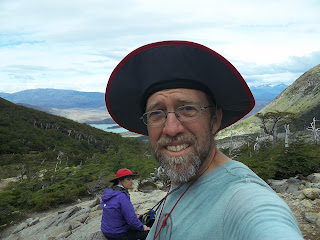So what do you do when you have been knocked out of the race after 2 days of racing. Well for one it was a full day boat ride back to Punta Arenas. That was pretty cool and we passed some incredible sites along the way.
On the boat back to Punta Arenas
Early monring on the deck of the boat
The southernmost point of the mainland Americas
Incredible waterfalls coming off the glaciers
Friends with the captain and crew
Once back in Punta Arenas we decided that we would take the bus to Puerto Natales and do what is one of the most amazing trips - Torres del Paine. Torres del Paine is a spectacular mountain range in the far northern tip of Patagonia. It is known for 2 fabulous hikes, the loop and the W. The loop normally takes 10-12 days and the W normally takes 5 but it can be done in 3. We planned to do it in 3.
The bus from Punta Arenas to Puerto Natales is probably the only thing that is a rasonable cost, about $10. It is a 4 hour bus ride, and once you get to Puerto Natales there are LOTS of very nice hostels. We stayed for one night in Hostal Geminis (about $14 per person) and that included breakfast. We booked the bus ride to Torres del Paine ($24 round trip) and the next morning we were off.
The park has an entrance fee of about $20 which is well worth it, even thought everything in the park does cost extra. We started the hike heading to the spires. It took us a few hours to get to the first refuge (Refugio Chileno) where we made camp, lightened our pack and headed up to the spires. They were incredible (attach pictures) On the way back Julie and Joe decided to head back to camp, but I was itching for more so jogged up to Campamento Japonese. A climber there had fallen in scree and broken some bones and the park rangers had sent most of the day trying to get him out. I dd not want to be another gawker so I headed back to Chileno.
Starting up the hill in Torres del Paine
Just a shot of me on the rocks
The beautiful lake and spires
A great spot for a picture
The glowing sunrise
Without me in the way
The Florida Orienteering sticker at Refugio Chileno
With new friends David and Emma along trail
We met some nice friend there from Santiagio, they were British teaching in Santiago, David and Emma. They were just finishing the W and David had blistered pretty badly on his feet so I helped patch him up with Leukotape. I also noticed (incredibly) that in the window of Chileno camp there was an old Florida Orienteering hotline sticker!
The next morning the sunris was incredible as it made the spires literally glow. After a good breakfast of peanuts and coffee we headed off on the long hike to Campamento Italiano. This was a pretty boring and long stretch, but once we made to to Campamento Italiano we were rewarded with French Valley and the ever present avalanches on the far side of the valley. The huge rumbles as the snow slid off the glaciar and down the mountain were fantastic. We sat and watched and filmed this for a while, but it soon got dark and we had to head back to the camp site. This was a very large and shaded camp site. It was also very crowded. One of the camps at the top of French Valley was closed, so folks could only stay in Italian Camp for a single night. I have no idea how they kept track of this. This was not really a full featured camp site and the next morning we made for Refugio Grey.
Hiking up the rocks to French Valley
Watching the avalanches in French Valley
Campamente Italiano at dusk
This was going to be a long day of hiking. We stopped for lunch at Los Cuernos, a really nice refuge along the trail that served food (only $6 for a soda!). We made it to Camp Grey early afternoon and after setting up the tent I decided to head up the mountain to see the glaciar. I was able to jog (no pack) most of the way and a quick scramble on the rocks placed me at a wonderful spot above the glaciar. I met some folks there and we chatted for a while and took picutres.
Climbing down to Grey Glacier
A nice view from above
Refugio Grey - a nice spot
By the time I got back to the camp I had found that they were going to turn on the hot water at the camp for a few hours at 6 PM. I immediately got in line for the chance to be clean and have a nice hot shower - I also washed some clothes that were beginning to get pretty rank.
We found that instead of hiking out we could take a boat from Camp Grey to the Glaciar and Hotel Gray. The glaciar was amazing and the hotel was amazing. Because of language barriers (very few park workers speak any English at all) there was a lot of confusion about how we would get back, but that all sorted out and that evening we were back in Puerto Natales.
Icebergs floating around
On boat Salt II in front of glacier
A bit of a better shot.
A little Milodon shopping


































